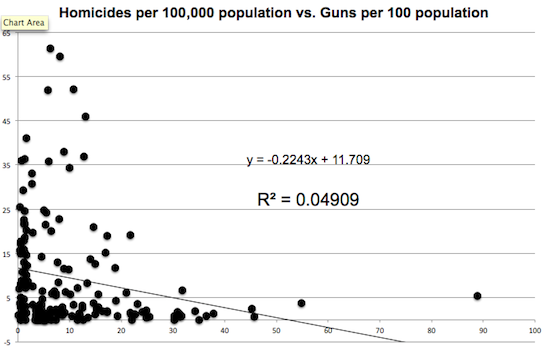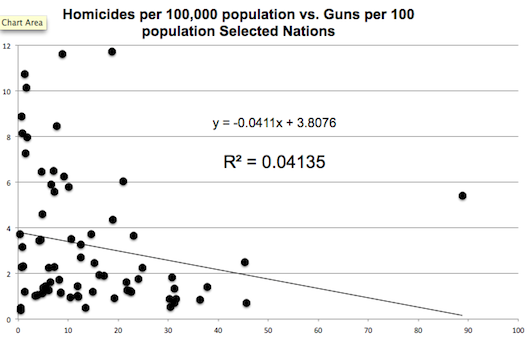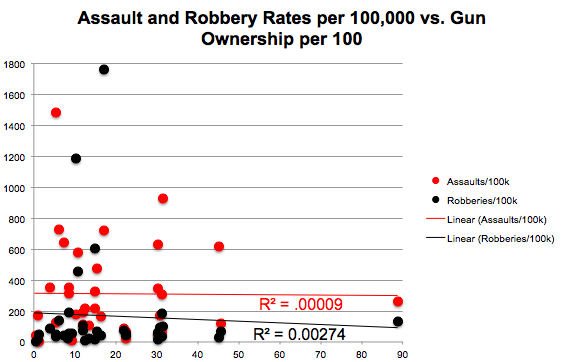Editor’s Note: This post is a follow-up to Alex Berezow’s “The Correlation Between Gun Ownership and Homicide Rate.”
Controlling and regulating gun ownership is for the purpose of making society safer by reducing the rates of murder and violent crime. Does this premise hold true? That is, do fewer guns per capita correlate with a safer country?
Recently, Alex Berezow analyzed the correlation between the number of privately-owned guns per capita in a country and the rate of homicide by firearms. This is a sensible first step to answer the question of whether reducing the number of guns in a society makes it safer. However, the greater purpose of gun control is not to reduce firearm homicide specifically, but to reduce the overall rates of murder and violent crime in a country.
While it is easy to concede that committing murder with a firearm is easier than committing murder with a less powerful weapon, reducing the number of guns might cause an increase or decrease in murder and violent crime for other reasons. A few lines of thought pop to mind.
A country which has high gun ownership might also have fewer robberies, assaults, and murders due to people defending themselves with firearms. Gun control might reduce the number of firearm homicides but cause an increase in non-firearm homicides. Countries with gun control might be more developed, safer, and have less violent crime for other reasons, just as countries with high numbers of guns might have more crime due to more guns. Robbery or assault rates might increase without private citizens being able to use a firearm to protect themselves.
A simple correlation analysis cannot tell us which of these ideas, if any, are correct, but it can shed light, to some degree, on whether gun control is associated with less violent crime. Let’s look first to see if there is a correlation between the number of guns per capita and the number of intentional homicides, of all types, per capita in 172 countries:

The answer, clearly, is no. In fact, the statistically insignificant trend is toward slightly (as inferred from the negative slope of the line) fewer homicides as gun ownership increases.
Further, we will follow Alex’s lead investigating this correlation by removing some countries. Let’s remove all countries with very poor development (e.g., some African and South and Central American states), states with extremely high murder rates (nearly all of which have very low gun ownership) and states currently involved in civil wars or major domestic unrest. This leaves 72 more developed countries to analyze. Are homicide rates higher in these countries with more guns?

The answer is still no. There is no reasonable way to cherry-pick any sample of countries to arrive at a significant correlation, or even a hint that reduced gun ownership lowers overall homicide rate.
Homicide is not the only violent crime that citizens have to fear. Robbery and assault are also important to consider, and it’s possible that firearms in the hands of law-abiding citizens might prevent them. There is reliable data on assault and robbery for about 35 countries, most of which we would consider well-developed and modern. Is there a correlation between robbery and assault and gun ownership rate?

There is no correlation between lower gun ownership and lower rates of assault and robbery, just as there is no correlation between a lower homicide rate and lower gun ownership. This statistical analysis provides no explanations, but it does point out a surprising fact: you are no less likely to be a victim of violent crime in a country with fewer guns.
What conclusions can we draw from this data?
First, there is no correlation between the number of guns per capita and the overall homicide rate. So people who believe fewer guns will reduce the homicide rate may be wrong.
Second, there is no correlation between the number of guns per capita and the rate of assaults and robberies. So people who believe guns make society safer by reducing overall crime may be wrong, too.
Obviously, more research is needed.
Data sources: Gun ownership rate taken from 2007 world data compiled by smallarmssurvey.org. Homicide rate taken from 2008 United Nations data. Assault and robbery data compiled from 2006 U.N. data. This work assumes that gun ownership did not significantly increase or decline over the roughly 12-month period that separates this data set from the other two data sets.
This post originally appeared onRealClearScience, a Pacific Standard partner site.





